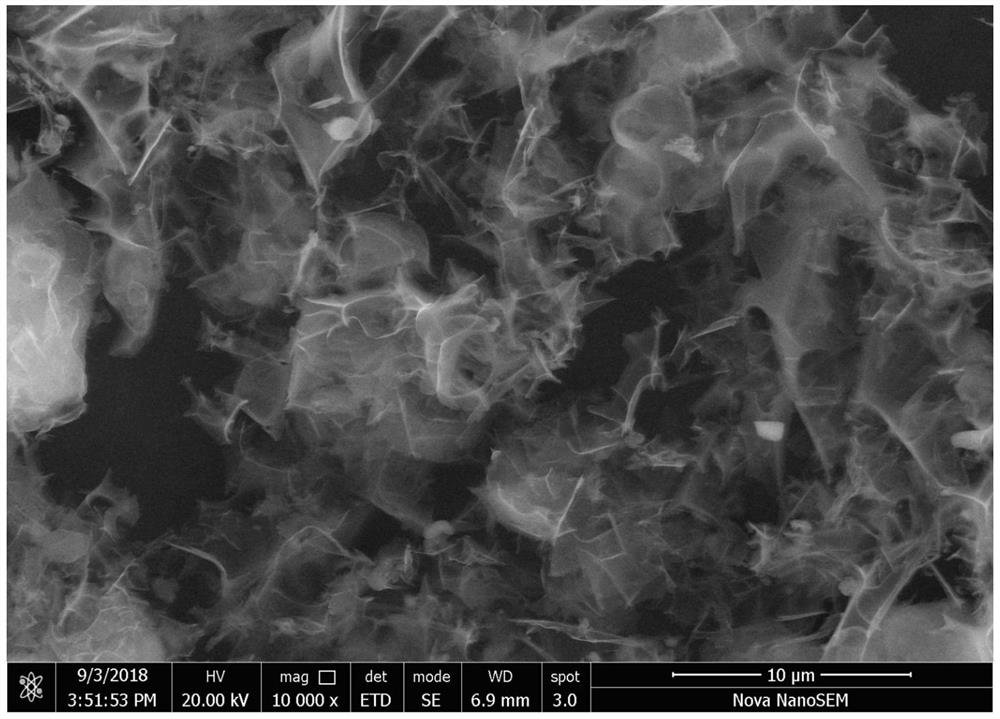Preparation method of a two-dimensional nanosheet structure transition metal-n-c material and its application in lithium-sulfur batteries
A two-dimensional nano-transition metal technology, applied in the direction of lithium batteries, structural parts, battery electrodes, etc., to achieve the effects of enhanced conductivity, uniform nitrogen doping, and accelerated charge transfer
- Summary
- Abstract
- Description
- Claims
- Application Information
AI Technical Summary
Problems solved by technology
Method used
Image
Examples
Embodiment 1
[0017] Weigh 3g of sodium chloride, 0.7g of glucosamine hydrochloride and 0.1g of ferric nitrate, dissolve them in 20mL of deionized water, stir and react for 40min, freeze at -12°C for 24h to form an ice crystal template, and freeze-dry for 12h to obtain carbonized Precursor.
[0018] In a tubular heating furnace, the carbonized precursor was heated to 800 °C for 3 h at a rate of 2 °C / min in an argon atmosphere, cooled to room temperature and then acid-washed with 1 mol / L HCl solution to wash away the salt template and load. The iron nanoparticles were freeze-dried to obtain a two-dimensional nanosheet structure Fe-N-C material. After the assembled battery test, the performance can reach 805mAh g under the test condition of 0.1C -1 .
Embodiment 2
[0020] Weigh 5g of sodium chloride, 1g of glucosamine hydrochloride and 0.3g of cobalt chloride, dissolve them in 30mL of deionized water, stir and react for 30min, freeze at -18°C for 12h, and freeze-dry for 12h to form an ice crystal template to obtain carbonized Precursor.
[0021] In a tubular heating furnace, the carbonized precursor was heated to 900 °C for 3 h at a rate of 2 °C / min in an argon atmosphere, and was cooled to room temperature and then acid-washed with 1 mol / L HCl solution to wash away the salt template and load. Cobalt nanoparticles were freeze-dried to obtain a two-dimensional nanosheet structure Co-N-C material. After the assembled battery test, the performance can reach 974mAh g under the test condition of 0.1C -1 .
Embodiment 3
[0023] Weigh 5g of sodium chloride, 0.5g of glucosamine hydrochloride and 0.1g of cobalt nitrate, dissolve in 25mL of deionized water, stir and react for 30min, freeze at -18°C for 12h, and freeze-dry for 12h to form an ice crystal template to obtain carbonized Precursor.
[0024] In a tubular heating furnace, the carbonized precursor was heated to 900 °C for 2 h at a rate of 2 °C / min in an argon atmosphere. After cooling to room temperature, it was acid-washed with 1 mol / L HCl solution to wash away the salt template and load. Cobalt nanoparticles, freeze-dried, and finally obtained a uniformly distributed ultrathin two-dimensional nanosheet structure Co-N-C material. After the assembled battery test, the performance can reach 1100mAh g under the test condition of 0.1C -1 .
PUM
 Login to View More
Login to View More Abstract
Description
Claims
Application Information
 Login to View More
Login to View More - R&D
- Intellectual Property
- Life Sciences
- Materials
- Tech Scout
- Unparalleled Data Quality
- Higher Quality Content
- 60% Fewer Hallucinations
Browse by: Latest US Patents, China's latest patents, Technical Efficacy Thesaurus, Application Domain, Technology Topic, Popular Technical Reports.
© 2025 PatSnap. All rights reserved.Legal|Privacy policy|Modern Slavery Act Transparency Statement|Sitemap|About US| Contact US: help@patsnap.com

